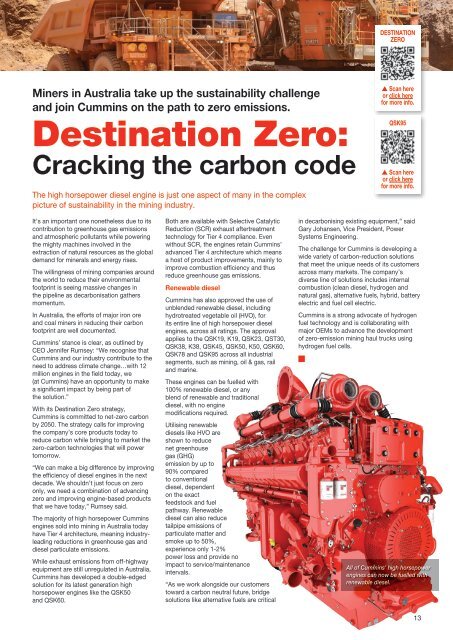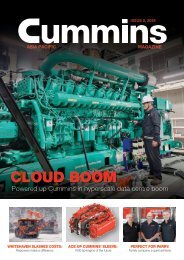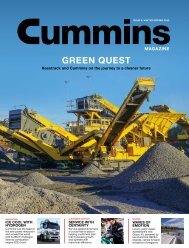Cummins Asia Pacific Magazine - Issue 1 2023
The 2023 edition of the Cummins Magazine for Asia Pacific is now available!
The 2023 edition of the Cummins Magazine for Asia Pacific is now available!
Create successful ePaper yourself
Turn your PDF publications into a flip-book with our unique Google optimized e-Paper software.
destination<br />
zero<br />
Miners in Australia take up the sustainability challenge<br />
and join <strong>Cummins</strong> on the path to zero emissions.<br />
Destination Zero:<br />
Cracking the carbon code<br />
The high horsepower diesel engine is just one aspect of many in the complex<br />
picture of sustainability in the mining industry.<br />
▲ Scan here<br />
or click here<br />
for more info.<br />
QSK95<br />
▲ Scan here<br />
or click here<br />
for more info.<br />
It’s an important one nonetheless due to its<br />
contribution to greenhouse gas emissions<br />
and atmospheric pollutants while powering<br />
the mighty machines involved in the<br />
extraction of natural resources as the global<br />
demand for minerals and energy rises.<br />
The willingness of mining companies around<br />
the world to reduce their environmental<br />
footprint is seeing massive changes in<br />
the pipeline as decarbonisation gathers<br />
momentum.<br />
In Australia, the efforts of major iron ore<br />
and coal miners in reducing their carbon<br />
footprint are well documented.<br />
<strong>Cummins</strong>’ stance is clear, as outlined by<br />
CEO Jennifer Rumsey: “We recognise that<br />
<strong>Cummins</strong> and our industry contribute to the<br />
need to address climate change…with 12<br />
million engines in the field today, we<br />
(at <strong>Cummins</strong>) have an opportunity to make<br />
a significant impact by being part of<br />
the solution.”<br />
With its Destination Zero strategy,<br />
<strong>Cummins</strong> is committed to net-zero carbon<br />
by 2050. The strategy calls for improving<br />
the company’s core products today to<br />
reduce carbon while bringing to market the<br />
zero-carbon technologies that will power<br />
tomorrow.<br />
“We can make a big difference by improving<br />
the efficiency of diesel engines in the next<br />
decade. We shouldn’t just focus on zero<br />
only, we need a combination of advancing<br />
zero and improving engine-based products<br />
that we have today,” Rumsey said.<br />
The majority of high horsepower <strong>Cummins</strong><br />
engines sold into mining in Australia today<br />
have Tier 4 architecture, meaning industryleading<br />
reductions in greenhouse gas and<br />
diesel particulate emissions.<br />
While exhaust emissions from off-highway<br />
equipment are still unregulated in Australia,<br />
<strong>Cummins</strong> has developed a double-edged<br />
solution for its latest generation high<br />
horsepower engines like the QSK50<br />
and QSK60.<br />
Both are available with Selective Catalytic<br />
Reduction (SCR) exhaust aftertreatment<br />
technology for Tier 4 compliance. Even<br />
without SCR, the engines retain <strong>Cummins</strong>’<br />
advanced Tier 4 architecture which means<br />
a host of product improvements, mainly to<br />
improve combustion efficiency and thus<br />
reduce greenhouse gas emissions.<br />
Renewable diesel<br />
<strong>Cummins</strong> has also approved the use of<br />
unblended renewable diesel, including<br />
hydrotreated vegetable oil (HVO), for<br />
its entire line of high horsepower diesel<br />
engines, across all ratings. The approval<br />
applies to the QSK19, K19, QSK23, QST30,<br />
QSK38, K38, QSK45, QSK50, K50, QSK60,<br />
QSK78 and QSK95 across all industrial<br />
segments, such as mining, oil & gas, rail<br />
and marine.<br />
These engines can be fuelled with<br />
100% renewable diesel, or any<br />
blend of renewable and traditional<br />
diesel, with no engine<br />
modifications required.<br />
Utilising renewable<br />
diesels like HVO are<br />
shown to reduce<br />
net greenhouse<br />
gas (GHG)<br />
emission by up to<br />
90% compared<br />
to conventional<br />
diesel, dependent<br />
on the exact<br />
feedstock and fuel<br />
pathway. Renewable<br />
diesel can also reduce<br />
tailpipe emissions of<br />
particulate matter and<br />
smoke up to 50%,<br />
experience only 1-2%<br />
power loss and provide no<br />
impact to service/maintenance<br />
intervals.<br />
“As we work alongside our customers<br />
toward a carbon neutral future, bridge<br />
solutions like alternative fuels are critical<br />
in decarbonising existing equipment,” said<br />
Gary Johansen, Vice President, Power<br />
Systems Engineering.<br />
The challenge for <strong>Cummins</strong> is developing a<br />
wide variety of carbon-reduction solutions<br />
that meet the unique needs of its customers<br />
across many markets. The company’s<br />
diverse line of solutions includes internal<br />
combustion (clean diesel, hydrogen and<br />
natural gas), alternative fuels, hybrid, battery<br />
electric and fuel cell electric.<br />
<strong>Cummins</strong> is a strong advocate of hydrogen<br />
fuel technology and is collaborating with<br />
major OEMs to advance the development<br />
of zero-emission mining haul trucks using<br />
hydrogen fuel cells.<br />
All of <strong>Cummins</strong>’ high horsepower<br />
engines can now be fuelled with<br />
renewable diesel.<br />
13





